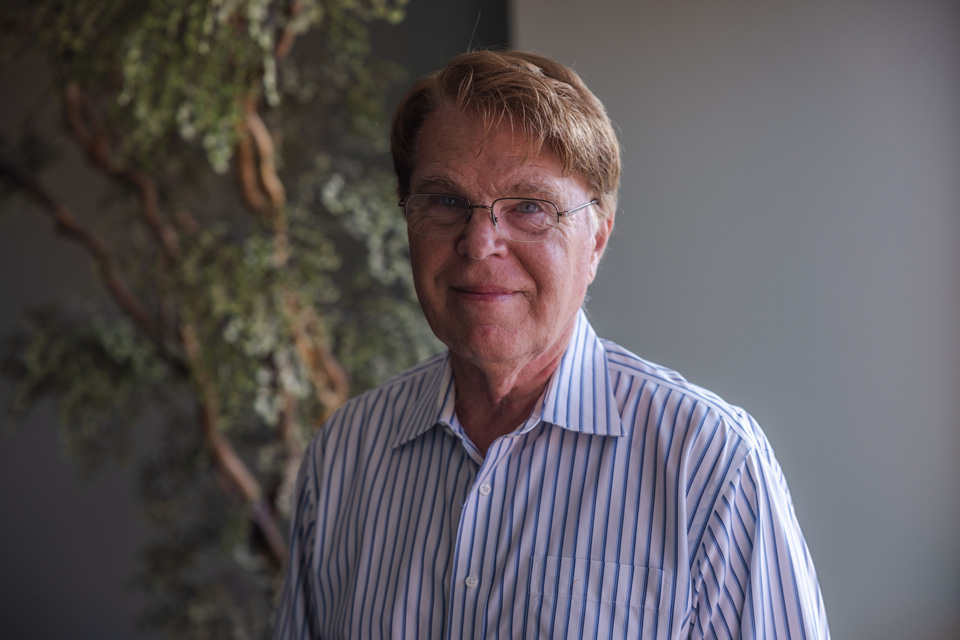After an extensive career in computer engineering, Doug Evans decided to take a chance and pursue his passion for genomics by re-training as a bioinformatician. Learn how his research is helping decipher the genomic underpinnings of diseases and how diversity has played a key part in his education and career.

What is your research focus?
As a bioinformatician in the Torkamani lab, and working with former Scripps Research faculty Silke Paust (now at The Jackson Laboratory), I support analysis of a wide range of study subjects, most notably where the role of gene expression can be used to explore and understand underlying human disease processes. Gene expression refers to the process where the information encoded in a gene gets turned on in a cell to make RNA and proteins. Over the past several years, single-cell RNA sequencing has emerged as a very useful assay for digging into and understanding what is going on at the most granular levels of human biology. Single-cell RNA sequencing combines several advanced techniques and technologies that allow for a very detailed picture to be drawn of what is happening within a diseased organ or tissue. This assay, and others like it, is revolutionizing our depth of understanding of biological processes formerly limited to studying only a few proteins or constrained by aggregating cell types within a single tissue or organ.
Is there a project that you are currently working on that you are particularly excited about?
I’m really excited about a project I’m doing with Silke Paust. We’re studying how certain cells in mice respond to infections and vaccines. These cells, called natural killer (NK) cells, are like special forces in our bodies that fight off sick cells. We’re using a method to look closely at the activity of genes in these cells. By comparing different samples, we can see how the genes change when the mice are exposed to different vaccines and viruses. Our goal is to find new treatments that could help people with HIV/AIDS stay healthier, maybe even finding a cure or a vaccine to stop infections.
What made you want to work at Scripps Research?
The journey that landed me at Scripps Research was long. Over my 35-year career up through 2014, I worked in highly technical jobs in product development and computer engineering, often leading large projects and managing large teams of multidisciplinary engineers. None of these jobs were related to biology or medicine. However, throughout all this time, I have been watching the revolution that was taking place in the field of genomics, especially with the Human Genome Project. Then, I discovered Massive Open Online Courses (MOOCs) and found a considerable commitment in the offerings that would allow me to transition into data science, specifically genomics. So, I quit my job as a director of engineering and went back to school (MOOCs) to see if I could find suitable courses and develop the right expertise to contribute to the field of genomic medicine.
After two years of intense re-education and attending many genomics conferences around the U.S., I attended the Future of Genomics Medicine 2016 conference, hosted by Eric Topol, founder and director of the Scripps Research Translational Institute. There, I realized Scripps Research could be a home for me. I especially liked the emphasis on collaboration and teamwork, as I knew that any contribution I made would be as part of a team. I asked Eric about potential opportunities for me at Scripps Research, and he pointed me to Ali Torkamani, director of Genome Informatics at the Scripps Research Translational Institute. I was able to join Ali’s lab as an intern, and after about a year, he hired me as a full-time lab member. And it’s been the fulfillment of a dream.
What does Diversity, Equity, and Inclusion mean to you?
I’ve been a champion of the principles of DEI for most of my life. When I attended university in the 1970s, my school—Cal Poly Pomona—was a significant landing place for many Vietnamese refugee immigrants, among whom I made many friendships. I also lived in a part of Pomona that is mixed race (white, Hispanic and Black), so I lived in a very integrated environment. Most of my female friends in college were feminists, and I found myself a close ally to them. In fact, for all these groups, I saw myself as one of them, despite my white male European ancestry.
During all this time, I witnessed what I considered to be the strength of our country, and that is its willingness to embrace outsiders or under-represented groups, for the betterment of everyone. I witnessed a growing awareness that there was an untapped resource in these groups. I took it as one of my missions to make sure that, to whatever degree of influence I have, I go out of my way to engage with and promote those who were potentially being left behind. I carried this thinking as foundational throughout my career as a hiring manager, especially in trying to overcome the exclusion of women in most areas of engineering. For example, it was common for companies to have 5 to 10 male engineers for each female engineer. I saw this as a lost opportunity, for both engineering as a discipline and for the individual women who otherwise might immensely enjoy and be excited by engineering as a career, as I was.
DEI also played a central role in my own recent career development. Entering Scripps Research as an older intern, alongside many young interns, immediately showed me how age and maturity can work for you. My intern experience positively influenced my outlook, especially because I saw how mentors helped boost the self-image of interns, both for myself and my younger peers. As I advanced in my role as a researcher, I proudly became a mentor to interns of my own, an experience which I find tremendously rewarding.